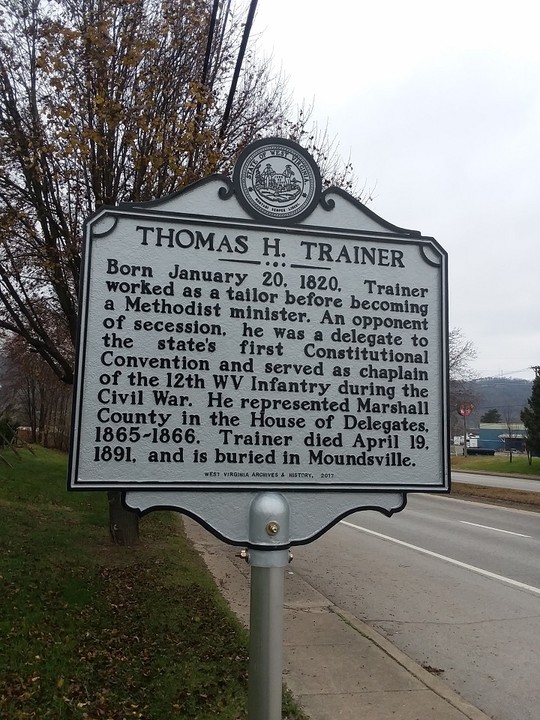Thomas H. Trainer Highway Historical Marker
Introduction
Text-to-speech Audio
Images
Thomas H. Trainer Highway Historical Marker

Trainer's commission letter signed by Governor Francis H. Pierpont (1862)
.jpg)
Backstory and Context
Text-to-speech Audio
Thomas Harvey Trainer was born on January 20, 1820 in Augusta County, Virginia in the Shenandoah Valley. As a young boy, he received some formal education before learning the tailoring trade. In June 1837, Trainer married Jane Maria Hart of Randolph County, Virginia (now West Virginia). The marriage would be a happy one, eventually producing roughly a dozen children. In 1853, Trainer decided to change vocations, leaving the tailoring trade to become a man of the cloth. After ordination, Trainer rode the circuit of the Western Virginia Conference of the Methodist Episcopal Church. One such congregation he tended to was that of the Methodist Episcopal church in Benwood, Marshall County, Virginia (now West Virginia).
During the Civil War, Trainer participated in the West Virginia statehood process and contributed to the federal war effort. In September and October of 1861, he organized three pro-statehood meetings in Marshall County, giving passionate and persuasive speeches at each of them. Later that same year, for the leadership role he assumed during the earlier pro-statehood meetings in the county, the residents of Marshall County selected Trainer as their delegate to the West Virginia Constitutional Convention, which met on November 26 in nearby Wheeling. As a Methodist minister, he was not alone. In fact, while nearly half of all delegates were farmers, ministers composed a significant proportion of those gathered and wielded considerable influence over the proceedings. In early October 1862, Trainer volunteered for military service and received a commission as a chaplain in the Twelfth (West) Virginia Infantry from Francis H. Pierpont, Governor of the Restored Government of Virginia. Mustered into service at Camp Willey on Wheeling Island on August 30, 1862, the regiment was assigned to Railroad District, Eighth Army Corps, Middle Department. Throughout the remainder of the year, the unit conducted scouting missions and guard duty in places such as Clarksburg, Buckhannon, and Wardensville. In late December, Trainer resigned his commission and returned home. His regiment would later achieve fame for its part in the capture of Fort Gregg in April 1865 during the Siege of Petersburg.
In 1865, politics beckoned Trainer once again. That year, residents of Marshall County elected him as their representative in the West Virginia House of Delegates. Trainer’s tenure in the lower house of the state legislature, however, proved short-lived. He would only serve until 1866.
Throughout the 1870s and 1880s, Trainer continued to ride the circuit and tend to his flocks in the state’s northern panhandle. In the early morning hours of April 19, 1891, he died at the age of seventy-one at the home of his son-in-law, Thomas Evans, in Benwood. According to contemporary newspaper accounts, he was one of the oldest ministers in the West Virginia Conference of the Methodist Episcopal Church. His remains are buried in Moundsville.
In 2017, as part of its Civil War sesquicentennial project, the West Virginia Highway Historical Marker Program of the West Virginia Archives and History erected a marker dedicated to Thomas H. Trainer. It stands along West Virginia Route 2 in Moundsville, Marshall County.
Cite This Entry
Brown, Cody and Francis Curran. "Thomas H. Trainer Highway Historical Marker." Clio: Your Guide to History. September 16, 2020. Accessed September 18, 2025. https://theclio.com/entry/96470
Sources
"12th Regiment, West Virginia Infantry," The Civil War: Battle Units Details. National Parks Service, U.S. Department of the Interior. Web. 15 September 2020 <https://www.nps.gov/civilwar/search-battle-units-detail.htm?battleUnitCode=UWV0012RI>.
Atkinson, George Wesley and Alvaro Franklin Gibbens. Prominent Men of West Virginia. Wheeling, WV: W.L. Callin: 1890.
Foulds, Matthew Tyler. "Enemies of the State: Methodists, Secession, and the Civil War in Western Virginia, 1845-1872." PhD diss., The Ohio State University, 2012.
Gooden, Randall S. "Constitutional Convention of 1861–63." e-WV: The West Virginia Encyclopedia. 08 December 2011. Web. 15 September 2020 <https://www.wvencyclopedia.org/articles/1566>.
Wheeling Register, April 20, 1891.
Wheeling Register, April 21, 1891.
Wheeling Register, April 23, 1891.
http://www.wvculture.org/history/markers/sesqui/thomashtrainer.html
https://www-fold3-com.www.libproxy.wvu.edu/image/267714212?terms=war,us,civil,h,thomas,148838,trainer,rel

